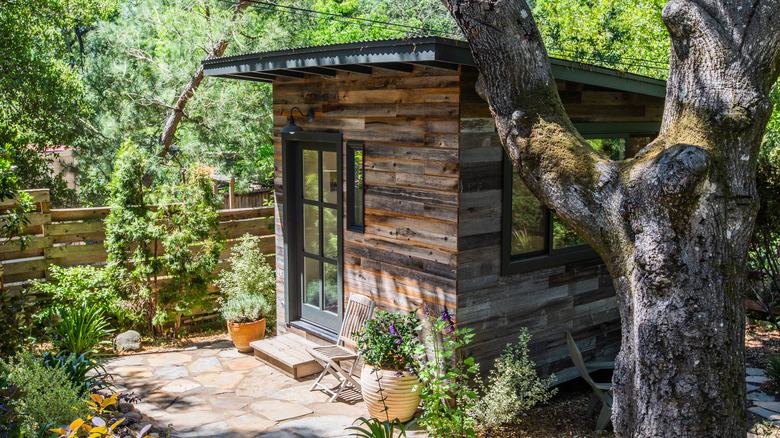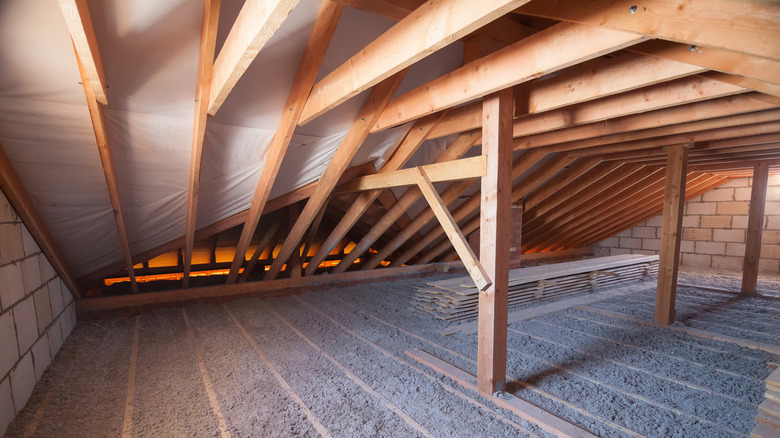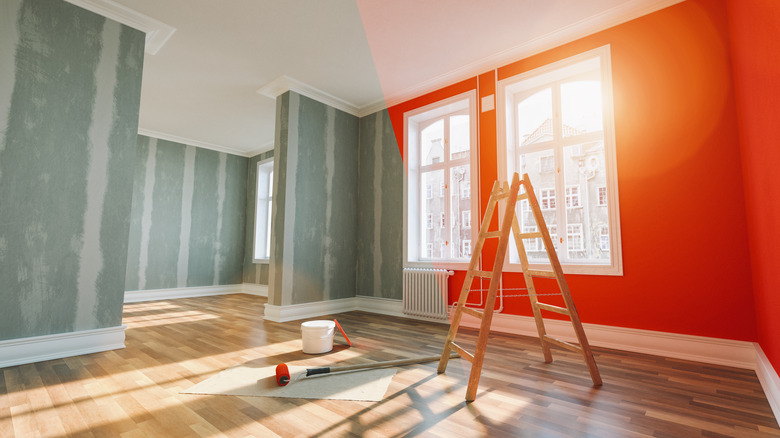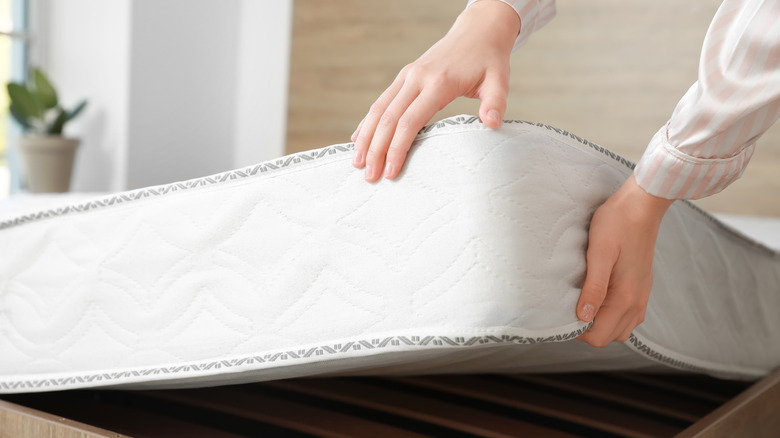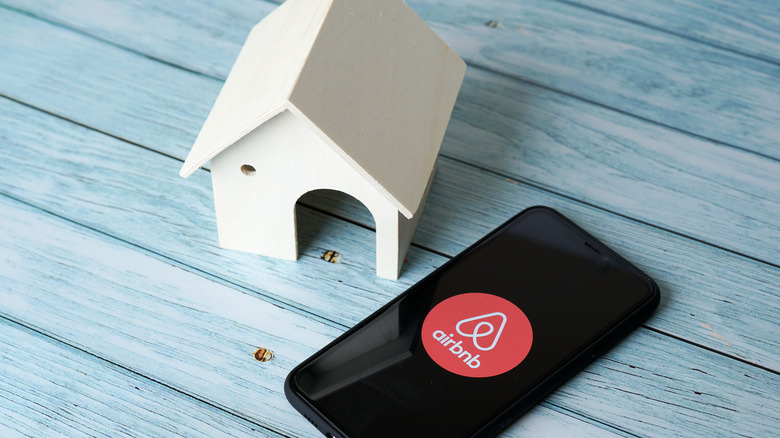How Much Does It Cost To Build A Mother-In-Law Unit From Scratch?
Mother-in-law units do not necessarily have to be intended for your mother-in-law to live in. The phrase "mother-in-law unit" is a common term used to describe an accessory dwelling unit, or ADU, which is legally defined as a residential unit that is located on the same lot of land as a single-family home, according to Better Homes & Gardens. Mother-in-law units can also be referred to as carriage houses, granny suites, guest houses, casitas, laneway houses, and coach houses, and they can be integrated into an existing home or serve as an entirely detached, separate structure.
Depending on the size of your intended mother-in-law unit, whether it will be a freestanding structure, and what amenities and features it will contain, the cost to build such a unit from scratch can vary quite a bit. Realtor reports that the cost to build a mother-in-law unit can range from $12,000 all the way up to $125,000, with the average sticker price coming in at around $75,000. The most common type of mother-in-law unit is the entirely detached structure, according to PropertyClub, although integrated units built within a pre-existing structure are rising in popularity.
Types of mother-in-law units
The decision to integrate your mother-in-law unit inside your house itself or to construct it as an entirely separate structure will have the biggest impact on your overall cost, but there are a variety of different ways you can construct your mother-in-law unit beyond the choice to attach or detach. To help you figure out the best option for your unit, you should take some time to analyze what your needs are for the space. If this unit will actually be intended for a mother-in-law or another family member going through the process of aging, you may want to avoid converting spaces like a basement or an attic because of the potential to exacerbate existing mobility issues. On the other hand, if your intended living space will be for an adult child who is maybe attempting to save on rent while still having an independent living area, a younger adult may think an attic space is trendy and cool.
Whatever type of space you end up moving forward with, you should aim for several basic core features within your mother-in-law unit: a bedroom, a bathroom, a kitchen area, and, ideally, a separate sitting room. This layout can take up quite a bit of space, which may also impact where you choose to construct your unit. Realtor provides a good breakdown of the different spaces often used to create the dream mother-in-law unit and how much each option can be expected to ultimately cost you.
Converting an existing garage
Turning a garage into a mother-in-law unit has a number of perks. First, garages are existing structures with a foundation, a roof, interior framing, drywall, and possibly electricity, meaning you will not have to pay to construct these aspects. They may also already have a private entrance that is separate from the rest of the home, or, if they do not, it will probably be very easy to design and construct one. The drawback with garages is that they are not designed to be habitable; they are simply intended to provide a structure to keep cars secure and out of the elements. Therefore, they typically do not feature such basic necessities as insulation, heating, air conditioning, and plumbing, and even if they are wired for electricity, it is very unlikely that they will contain enough wall outlets to meet the standards of most local residential building codes.
If you are converting your garage into a mother-in-law space, you will need to wire electrical components to come up to code for both wall outlets and to support major kitchen appliances, such as a refrigerator. The unit will need plumbing for the kitchen area and for the bathroom, and while with the garage option, you can likely extend the existing plumbing from the main house, that process is still fairly laborious and unlikely to be cheap. You will also probably need to extend the current heating and air conditioning system in the main house to cover the garage as well, and in order to make sure the heating and cooling actually works and doesn't just evaporate out, you will need to install insulation in your garage's walls (and potentially raise the floor to insert insulation below it too). All of these improvements and adjustments will run you anywhere between $20,000 and $50,000, with the bathroom costs alone setting you back $15,000 to $25,000, according to Realtor.
Converting an existing basement
If your basement is already a finished basement, defined by Ownerly as a space without bare foundation walls and a basic concrete floor, converting your basement space into a mother-in-law unit could be a fairly easy and inexpensive process. You will need to put up walls to divide the existing space into separate rooms and install kitchen and bathroom equipment, but all of the plumbing and electrical systems can be hooked up to pre-existing wires, pipes, and drains that serve the rest of the house. Realtor reports that you could probably knock out this kind of renovation for around $12,000.
If your basement is unfinished, that is a different story entirely. You will need to put in proper flooring and likely paint or otherwise spruce up the walls. You still have to pay for all of the above-listed costs of converting a finished basement, i.e., adding walls and hooking new plumbing and electrical up to existing systems, but you will have a host of other costs that don't come up when working with a finished basement.
These costs include installing a sump pump or French drain to prevent potential flooding, setting up a dehumidifier to mitigate mold growth by regularly removing moisture from the air, and, to keep your new basement living space up to residential building codes, providing easy "egress" or escape through a window, window wells, or a door that all lead to outside and above the ground. The entire process of converting an unfinished basement into a livable space will probably set you back around $33,000, per Realtor.
Converting an existing attic
As mentioned above, an attic space might not be the best option if you are looking into creating a mother-in-law unit that is actually intended for your mother-in-law or another elderly relative. But, if you're pursuing a mother-in-law space because you intend to rent it out for some side income or provide it for another family member without any mobility issues, attics are a great option. The one issue you may run into with an attic is related to building codes: in order for an area to be considered a "habitable space," most building codes require it to contain at least 70 square feet in which the ceiling is at least 5 feet tall or higher.
If your attic meets those standards, you can start looking into how much it would cost to convert the space into a mother-in-law unit. Many attics have a drop-down ladder as opposed to a staircase -– if this is the situation for your attic, you will need to build an actual staircase that is as least 36 inches wide (again, to comply with building codes). Attics are notorious for trapping heat in the summer and becoming drafty in the winter, so you will need to add insulation and connect your attic to your house's existing heating and air conditioning systems. As with all other internal conversions, you will need to extend your house's plumbing to the new kitchen and bathroom areas in the attic.
One consideration unique to an attic conversion is the level of noise. People living on the bottom floor of a multi-level living space are often negatively impacted by noise from the people living above them; even if the upper room tenants are not particularly loud, something as simple as walking across the floor can reverberate unpleasantly for downstairs tenants. Reinforcing the attic's floor joists (which also improves overall safety) and building in some floor sound-proofing can reduce the possibility of noise concerns. Finally, you will probably want to add in some electric lights or skylights to brighten up the attic's living space. All in all, converting your attic into a mother-in-law unit can cost you anywhere between $41,000 to $90,000, according to Realtor.
Converting unused rooms
If you happen to have an extra bedroom or office space that's currently sitting empty, or even a dining room or sitting room that is pretty much never used for actual dining or sitting, that is space you could potentially convert into a mother-in-law unit. Yes, converting existing rooms within your house is the least private of all of the listed options, although in some cases, you may be able to get away with installing a new door into the space that leads directly outside, creating a separate entrance. But, converting an unused room into a mother-in-law unit is potentially one of the cheapest ways to create a new living space, so it shouldn't be discounted offhand.
Converting an existing room into a mother-in-law unit will save you costs on building flooring, sub-flooring, and walls, all of which presumably already exist in the space. You also will not have to worry about the cost of connecting a new space to your home's heating and air conditioning system. You may have fewer options when it comes to space for your mother-in-law unit, so it's possible you will have to forego adding in such amenities as a kitchen (converting an unused room may be a better option if the space is truly intended for a family member, as opposed to a short-term rental for strangers). But, most rooms in a house could be subdivided into a bedroom and a bathroom, or a bedroom and a sitting area if there happens to already be a bathroom close by.
Converting an unused room into a mother-in-law suite will likely involve framing and building a new wall and potentially adding in plumbing, tile, and electrical wiring for a new bathroom. Realtor reports that creating a new wall usually costs between $2 and $4 per square foot of wall space, and putting in a new bathroom can set you back anywhere from $3,000 to $25,000, depending on the size and amenities provided. If you want to expand the existing space out to potentially make it large enough to accommodate a kitchen, you will also need to pay to expand your home's foundation and to paint and side the addition so that it matches the rest of your house, which will cost you between $80 and $200 per square foot of additional space.
Building an entirely separate accessory dwelling unit (ADU)
Your home may not have a garage, a basement, an attic, or a decent-sized unused room –- or you may already be using those spaces for storage or other purposes. This situation does not mean you can't build a mother-in-law unit. You can build what is known as a detached accessory dwelling unit, or ADU, i.e., an entirely separate structure from your main house. This option is a substantially steeper investment than converting an existing or attached space, with HomeAdvisor reporting that the average cost to build a detached ADU is around $83,000 but can go all the way up to $125,000. The good news about detached ADUs is that they often meet the definition of a "tiny house," which, according to the International Residential Code, is a living space that is under 400 square feet. Tiny houses are rising in popularity for short-term rental options, so a detached ADU could help pay for itself pretty quickly.
If your ADU is intended for an elderly family member, you could choose to go with a "granny pod" for your mother-in-law unit. CountryLiving reports that these structures can be designed from the ground up or can come already pre-built and shipped and often feature components of safety and accessibility specifically intended for an older occupant. These aspects can include hand railings, on-site defibrillators for use in the event of a heart attack, extra first aid supplies, lighted floorboards, double French doors to accommodate a wheelchair and other medical equipment, and a soft floor to minimize the possibility of injury from an unexpected fall.
Factors for cost
No matter what type of mother-in-law unit you choose to go with, there are going to be a number of factors that influence the overall cost that you just can't avoid.
Location
If you are attempting to add a mother-in-law unit to an existing property in an area with a high cost of living, you are going to end up paying more than you would in a cheaper area. Labor costs and possibly materials costs will be higher. But there is a more specific layer of the location to consider as well: if you are going the detached ADU route, you need to figure out where exactly on your property you are going to place your new unit. Detached ADUs require their own foundation, so you will need to incorporate excavation costs into your overall budget. If you are attempting to excavate in a rocky area or an area with a lot of clay in the soil, the excavation will take longer, and your contractor will likely end up charging you more. Yahoo reports that excavation costs come out to around $70 per cubic yard, on average.
Materials
The cost of materials may end up being the most complicated aspect of the budget for your new mother-in-law unit, according to HomeAdvisor, which provides a thorough breakdown of all materials costs. As mentioned above, you will need to start out with a foundation, provided you aren't attaching your unit to a pre-existing structure. Your foundation will need to be well-constructed and lode-bearing -– no cutting corners here. It will likely end up costing you between $400 and $700 for every 100 square feet.
Unless you are converting a garage, basement, or attic, you will also need a supportive frame, a roof, and filled-in drywall, so that your mother-in-law unit is sheltered from the elements. HomeAdvisor reports that support beams and roof trusses cost between $15 and $30 per square foot, while drywall runs between $400 and $600 for every 100 square feet. And you can't forget the insulation, which you may also need to add in to some of those garage or basement areas you are converting. Insulation costs between $0.30 and $1 per square foot.
Plumbing pipes and fixtures will also add up. For every 100 square feet of your new mother-in-law unit, you will likely need to pay $1,500 to $4,000 for plumbing pipes, per HomeAdvisor. The cost of plumbing fixtures can vary widely, depending on how fancy you want to get. You should keep in mind that your new unit will need a sink faucet and a sink for both the kitchen and the bathroom areas, as well as at least one showerhead, bathtub, and toilet, so seven plumbing fixtures in all at the minimum. You will probably end up spending anywhere between $400 and $2,000 on each fixture, so budget accordingly.
The cost of flooring can also range based on how much you are willing to pay for a more aesthetically appealing space. Your cheaper options include laminate and vinyl flooring, while marble, hardwood, and tile flooring will be more expensive. According to HomeAdvisor, you can expect to pay between $5 and $20 for every square foot of floor space, and remember that you will probably want at least two different types of flooring within your unit (most people appreciate having a separation between the flooring in the bathroom area and the flooring in the rest of the living space).
Interior and exterior doors will cost you between $500 and $5,000 apiece, per HomeAdvisor, and the total cost can depend on how simple or ornate you want your entryways to be. Windows are usually between $100 and $1,500. Painting your new mother-in-law unit's interior will cost you around $5,000, while painting the exterior will set you back closer to $8,000 (although, remember you may not need to invest in exterior paint for units that convert an existing space, such as an attic). Adding siding to your unit's exterior averages around $12 for every square foot, which comes out to close to $10,000 for an average detached ADU.
If you are going the detached route, keep in mind that you will also need two extra investments: an electric meter, which HomeAdvisor reports usually costs between $2,000 and $5,000, and a water heater, which can run anywhere from $600 to $3,000.
Labor
You can save costs on many at-home projects by completing all of the labor yourself, i.e., investing your time instead of your money. Building a mother-in-law unit from scratch is not one of those projects. Unless you are some combination of architect, plumber, electrician, and HVAC expert, you will need to hire at least a few professionals and compensate them accordingly. HomeAdvisor has a thorough roundup of all of the costs you can expect to shell out for the different kinds of labor you will need.
To plan out the design and layout of your mother-in-law unit, you are going to want to bring in a professionally trained architect. Having an educated and informed eye on your project's design is especially important if you are intending for this unit to be the living space for an older family member, as an architect can make the unit as accessible as possible, particularly for someone who may have impaired mobility. A good architect will charge around 10% to 20% of your project's overall cost, according to HomeAdvisor.
You will need a plumber to install a water main line for the kitchen and bathroom sinks and a sewer main line for the bathroom. Per HomeAdvisor, plumbers usually charge around $200 per hour, although you may find one that charges per project, in which case you can expect to pay between $600 and $2,500 for the water main line and between $1,500 and $5,000 for the sewer main line. If you are not building a detached unit, though, you could get away with connecting new pipes to existing water and sewer lines, in which case you might only end up paying between $300 and $2,000 for the whole plumbing installation.
The same principle applies to both electricians and HVAC specialists: if you are extending a current system, it will cost you less, but if you are creating an entirely new system for a whole separate unit, the project could end up setting you back quite a bit. HomeAdvisor reports that electricians typically charge an hourly rate of between $50 and $100, meaning the more time they spend on wiring a new system, the more you will have to shell out. For a new HVAC system, you should expect to pay around $7,500, but people often reduce this cost by going with what's referred to as a "mini-split" system, or one that is specifically designed with ducts, vents, and air returns intended for smaller spaces.
Beyond architects, plumbers, electricians, and HVAC specialists, you may need to hire additional contractors for various other assorted projects associated with your new mother-in-law unit. Much of the additional work beyond constructing and installing your unit could be done on a DIY basis, including laying floors, installing windows, and painting, but if you do not have a ton of experience in those areas, it may be more effective to hire a contractor (and ultimately cheaper in the long run, if your lack of knowledge leads to a subpar job that needs to be redone). If you are building a separate ADU, you may want to go with a general contractor who will oversee all other contractors on the project and will typically charge 10% to 20% of the total project cost, with laborers working under the main contractor costing between $100 and $300 apiece per day of labor, per HomeAdvisor.
Additional costs
Beyond the bare bones of getting your new mother-in-law unit constructed and functional, you should budget for some extra costs that may come up in the process, depending on your needs and aspirations for the unit.
Universal design
The principles of universal design make a space accessible to everyone regardless of ability or disability, according to the National Disability Authority. While the principles of universal design are perhaps most applicable in the case of older adults who want to age in place, even if you are intending for your mother-in-law unit not to accommodate an elderly family member but instead to be used as an Airbnb, it is still good business practice to design a rental space that is easily navigated by all prospective tenants.
Realtor notes that a living space created with universal design in mind would likely incorporate wide doorways and raised cabinets to accommodate wheelchairs and walkers, shower stalls without lips and bathtubs with sides that can open to prevent tripping, and walls reinforced with plywood on the interior so that they can serve as anchors for grab bars if necessary. Other considerations from CountryLiving include slip-resistant floors, rounded countertops, and lever door handles, which most people find easier to grip than circular knobs, but are more accessible in particular for those with shakier hands.
Storage
If you are converting your garage, attic, or basement into your future mother-in-law unit, odds are that you didn't come to that decision because the space was sitting completely empty and unused. If, like most Americans, you have been using those areas as a storage space, you are going to need to find a new place to keep all of your stuff.
If your mother-in-law unit is intended to be a short-term rental space, you could get creative with some in-unit storage options, such as under the bed or by using furniture pieces that contain interior storage space, as many couches do. However, if your mother-in-law unit is intended to accommodate a family member, chances are that they will have their own storage needs, and you likely can't count on storing your items in what will be their new home. Renting a storage unit will cost you anywhere between $100 and $300 a month, according to Move.
Furniture and appliances
A mother-in-law unit for your actual mother-in-law or another family member may not need any furniture, as your new tenant will probably bring their own, although keep in mind that some furniture pieces may need to be swapped out or upgraded for an elderly family member, such as a bed that can be raised and lowered. For a new short-term rental, though, you will likely need to furnish the entire place.
BuildYourBnB provides a breakdown of the amount it will cost to fully set up your future AirBnB. The bedroom will require a bed frame, mattress, nightstand, and lighting, and potentially also a desk, desk chair, additional sitting surface, and some decorative art, depending on the space, all of which will likely cost between $1,000 and $2,000. For your living room, you will need a couch, coffee table, chairs, lighting, and decorations, which will run you around $2,000. A kitchen dining table and chairs will set you back between $500 and $1,000. And don't forget all of the little, non-furniture supplies you need to live in a space: sheets, towels, pillows, blankets, throws, dishes, pots, pans, utensils, etc. You should budget around $2,000 for those miscellaneous odds and ends.
Your mother-in-law unit will also need appliances, and unfortunately, you will probably have to spring for those even if your unit is intended for a family member, as appliances are usually not transferred from house to house. Angi reports that a washer, dryer, fridge, range, oven, and dishwasher will likely cost you between $1,000 and $8,000. It is up to you how much you want to include in your unit – for example, many AirBnBs get away with providing a mini-fridge as opposed to a full-size option, which can save you a few dollars.
Benefits of a mother-in-law unit
No matter what your needs or intentions are in setting up a new mother-in-law unit, it is likely that you will be reaping the benefits for years to come, especially as these units become more popular. All of the cash you sink into building your unit will probably see significant investment returns in a variety of ways.
Multigenerational living
If your mother-in-law unit is intended to accommodate an older family member, you will be joining the millions of Americans who already live in multigenerational households. According to the Pew Research Center, more Americans identify as living in a multigenerational household now than at any other point in our country's history, and it's not hard to see why. With housing and rental costs ever rising, combining multiple generations of the same family makes good economic sense, whether that means a space for an adult child to live with a degree of independence while they save up some money or a space for an elderly family member to live in safety and proximity as opposed to a nursing home. Families with multiple generations living under the same roof also report lower childcare costs, as other family members can typically help out with care and reduce some of that cost burden.
Airbnb, VRBO, and other short-term renting
Of course, if multigenerational living is not the goal, your mother-in-law unit won't just save you money; it could make you money –- and quite a bit of it, too. CNBC reports that hosts of an Airbnb rental unit make an additional $924 per month in rental income, which can make a significant dent in your mortgage payment or other expenses. With short-term renting, however, you should always look into local restrictions and zoning policies before hosting, as some municipalities restrict the number of AirBnBs and many others require permits, licenses, or other registration with the city government. If short-term renting is not an option for you, you could look into long-term tenants, who may pay less month to month than you could get for an Airbnb, but will still provide you some measure of extra income.
Resale value
The resale value of a mother-in-law unit varies depending on how you have constructed the space. If it has its own dedicated entrance, and if it has a kitchen, bathroom, and living space that are entirely separate from the bedroom – basically, if whoever buys your house in the future could potentially rent the space out –- a mother-in-law unit can increase your home's market value by 7% to 10%, according to HomeLight. Mother-in-law units tend to add more value to a home that is located in a hot real estate market, which, let's face it, is pretty much everywhere these days.
